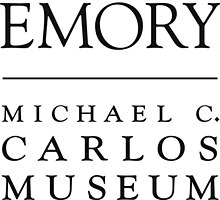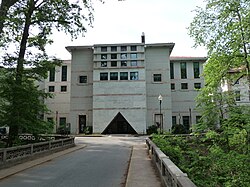Michael C. Carlos Museum
 | |
 | |
 | |
Former name | Emory University Museum of Art and Archaeology |
|---|---|
| Established | 1876 |
| Location | 571 South Kilgo Circle Atlanta United States |
| Type | Art museum |
| Visitors | 120,000 annually |
| Director | Henry Kim |
| Website | carlos |
TheMichael C. Carlos Museumis an art museum located inAtlantaon the historic quadrangle ofEmory University's main campus. The Carlos Museum has the largest ancient art collections in the Southeast,[1]including objects fromancient Egypt,Greece,Rome,theNear East,Africaand the ancient Americas. The collections are housed in aMichael Gravesdesigned building which is open to the public.[2]
History[edit]

One of the oldest museums in Georgia, the museum's collections date back to 1876, when a general museum known asEmory College Museumwas established on Emory University's original campus in Oxford, Georgia. After the university was relocated to Atlanta, a small group of professors officially founded the Emory University Museum in 1919. The collections were housed and displayed in various buildings around the campus.[2]
Over the years, Atlanta businessman Michael C. Carlos donated over $20 million to create a permanent home for the museum, which opened in 1985. The museum was renamed again to the Emory University Museum of Art and Archaeology and was officially accredited by theAmerican Alliance of Museumsas a museum of antiquities and fine arts. Carlos died in December 2002 at the age of 75.[3]
A major expansion in 1993 transformed the museum into one of Atlanta's top arts institutions. Upon the new building's opening, the museum became known as the Michael C. Carlos Museum, named after its most generous patron.
During the1996 Summer Olympics,the museum presented two major exhibitions: one on the Emory campus highlighting the work ofThornton Dialand the other in City Hall East (nowPonce City Market) titled "Souls Grown Deep: African American Vernacular Art of the South". Originally pitched to theHigh Museum of Art,the latter exhibit featuredfolk artandself-taught artfrom African-American artists across the American South, curated by local art collectorWilliam S. Arnett,and opened to "glowing reviews".[4]
In June 2022, it was announced that Henry Kim would be the new associate vice provost and director of the Museum beginning August 22, 2022.[5]
Collection and activities[edit]
The museum's collections comprise more than 25,000 works,[6]and the facility attracts 120,000 visitors annually. In addition to permanent and temporary exhibitions, the museum is a source of educational programming, providing lectures, symposia, workshops, performances, and festivals. The Carlos Museum also operates a teaching laboratory and conservation center, and publishes scholarly catalogues. The museum also brings art, history, and archaeology to the classroom of Georgia children through its outreach program, Art Odyssey. The Carlos Museum also runs Odyssey Online, a Web site for school-age children that explores the various cultures reflected in the museum's collections.[2]
The museum's permanent Egyptian holdings were bolstered with the acquisition of 145 works from Canada'sNiagara Falls Museumin 1999. The elaborately decorated ancient coffins and mummies of both humans and animals form the centerpiece of the permanent exhibition of ancient Egyptian art. Also in 1999, Carlos bequeathed a $10 million gift specifically for the purchase of ancient Greek and Roman pieces. As a result, the museum now owns and exhibits the finest existing portrait of the Roman emperorTiberiusand one of the country's best examples of Hellenistic sculpture, adepiction of Terpsichore,the Greek muse of dance. A total of 450 works of art are now on display in galleries devoted to Greek and Roman art.[2]
In 1999, the Carlos Museum purchased an unidentified male mummy that some thought could be a New Kingdom pharaoh. Through research and collaboration with Emory University medical experts, museum scholars were able to identify the mummy as pharaohRamesses I.The museum returned the mummy to Egypt in 2003 as a gift of goodwill and international cultural cooperation.[7][8]His remains are permanently on display in a plexiglass case at theLuxor Museum.[9]
On June 6, 2006 the museum purchased a headless statue of Venus, for $968,000 at a Sotheby's auction in New York. A private collector inHouston, Texas,agreed to sell to whoever purchased the body, the head as well, which was last documented attached to the body in 1836. The head was sold for an additional $50,000.[10]
In November, 2023, The Ministry of Culture of the Republic of Italy and Emory University announced that they reached an agreement for cultural cooperation which includes the restitution to the Ministry of five objects in the collection of the Michael C. Carlos Museum at Emory, with three of the objects remaining on loan to Emory.[11]At least 562 artworks in the museum collection are alleged to have had sellers linked by authorities to the illicit antiquities trade.[12]
On Jan. 22, 2024, Emory University and the Ministry of Culture of the Hellenic Republic signed a long-term agreement of cultural cooperation, which includes more educational opportunities for students and the return to the Greek ministry of three objects in the collection of the Michael C. Carlos Museum at Emory.[13]In 2023, the Michael C. Carlos Museum also returned an Assyrian ivory furniture applique to the government of Iraq following research which revealed that it belongs to the Iraq Museum.[14]
References[edit]
- ^AOL."AOL Travel - Deals, Discounts and Things to Do".AOL.Retrieved16 April2018.
- ^abcd"Michael C. Carlos Museum of Art".New Georgia Encyclopedia.Retrieved16 April2018.
- ^Emory Magazine, Winter 2003."Remembering Museum Benefactor Michael C. Carlos".RetrievedAugust 7,2006.
{{cite web}}:CS1 maint: numeric names: authors list (link) - ^Dylla, Sarah (September 23, 2020)."Not Just Sports: Arts and Culture of the '96 Games".Atlanta History Center.
- ^"Henry S. Kim selected as new director of Emory's Michael C. Carlos Museum | Emory University | Atlanta GA".news.emory.edu.Retrieved2022-06-24.
- ^"Vice Provost for Libraries and Museum – Emory University | Association of Academic Museums and Galleries".Retrieved2021-11-18.
- ^"Egypt's 'Ramses' mummy returned".BBC.26 October 2003.Retrieved2008-04-13.
An ancient Egyptian mummy thought to be that of Pharaoh Ramses I has returned home after more than 140 years in North American museums.
- ^"U.S. Museum to Return Ramses I Mummy to Egypt".National Geographic.April 30, 2003. Archived fromthe originalon May 2, 2003.Retrieved2008-04-13.
A 3,000-year-old mummy that many scholars believe is ancient Egypt's King Ramses I is the star attraction of an exhibit at the Michael C. Carlos Museum in Atlanta that will run from April 26 to September 14.
- ^Hart, Ariel (25 October 2003)."A Journey Back to Egypt for a Mummy Thought to be a Pharaoh".The New York Times.
- ^Dell'orto, Giovanna (June 13, 2006)."Museum to Reunite Venus Statue With Head".Associated PressinWashington Post.Retrieved2008-04-13.
For the first time in possibly 170 years, a Roman marble statue of Venus will be reunited with its head as both are coming to the Michael C. Carlos Museum at Emory University, where conservators will piece them back together.
- ^Emory University (November 9, 2023)."Emory, Ministry of Culture of the Republic of Italy enter into cultural cooperation agreement".Emory News Center.RetrievedMay 23,2024.
- ^Lee, Stephanie M. (August 23, 2023)."The Little Museum's Big Score: Emory University Wanted Only the Finest Antiquities. It Didn't Ask a Lot of Questions".Chronicle of Higher Education.RetrievedMay 23,2024.
- ^Emory University (January 22, 2024)."Emory, Ministry of Culture of the Republic of Italy enter into cultural cooperation agreement".Emory News Center.RetrievedMay 23,2024.
- ^Carlos Museum (January 22, 2024)."Nimrud Ivory Returned to the Republic of Iraq".Michael C. Carlos Museum.RetrievedMay 23,2024.
External links[edit]
- Emory University
- Institutions accredited by the American Alliance of Museums
- Michael Graves buildings
- University museums in Georgia (U.S. state)
- Museums in DeKalb County, Georgia
- Museums in Atlanta
- Art museums and galleries in Georgia (U.S. state)
- Egyptological collections in the United States
- Museums of ancient Rome in the United States
- Museums of ancient Greece in the United States
- Museums of Ancient Near East in the United States
- Art museums and galleries established in 1876
- 1876 establishments in Georgia (U.S. state)
- New Classical architecture
- African art museums in the United States

